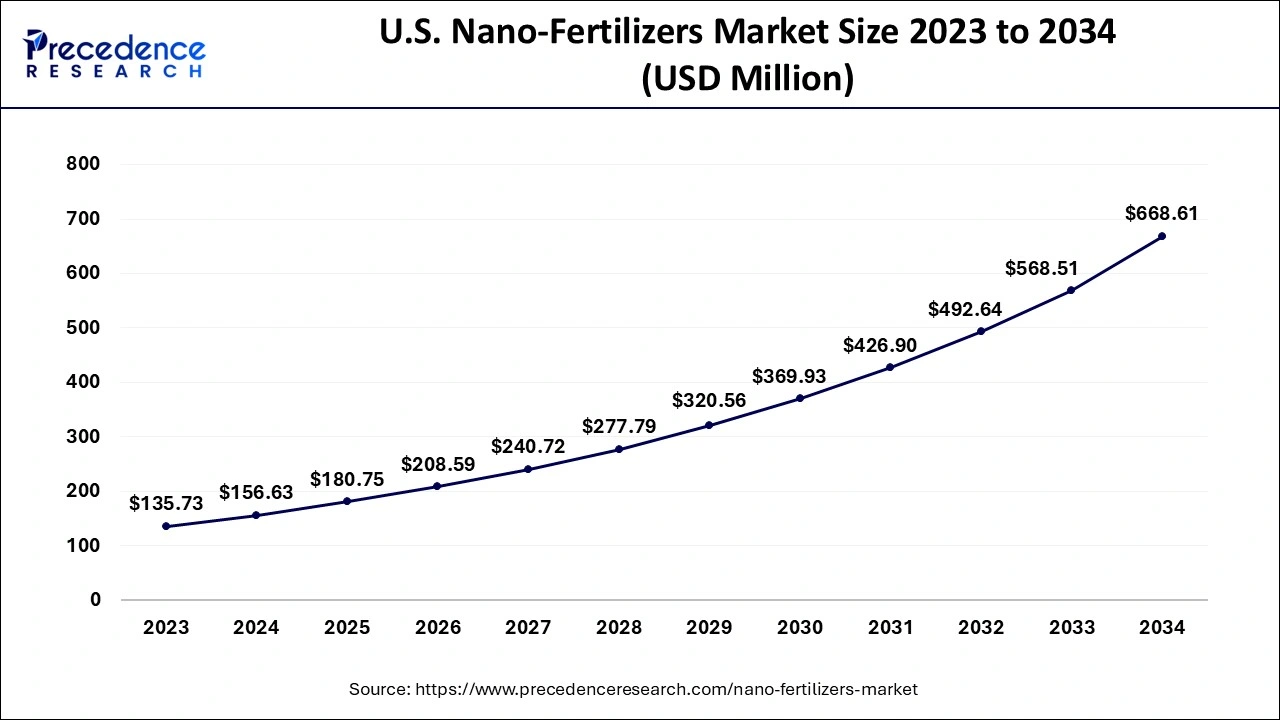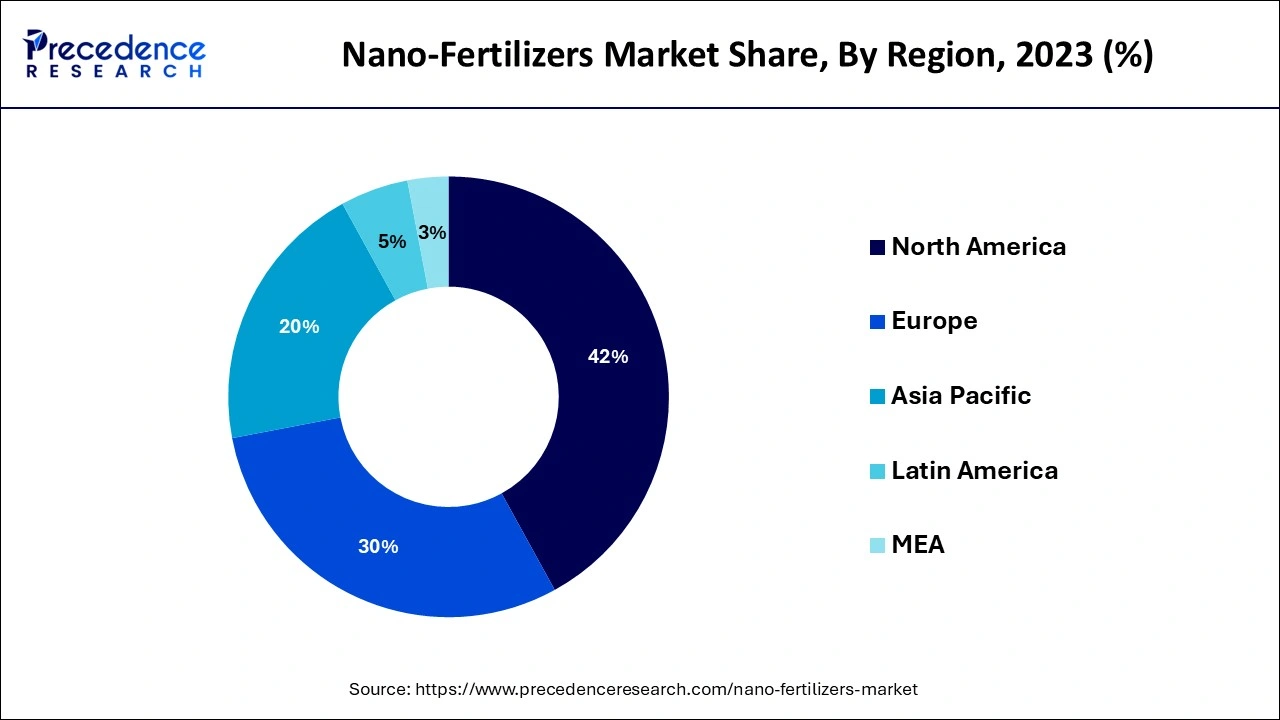November 2024
The global nano-fertilizers market size accounted for USD 532.77 million in 2024, grew to USD 614.81 million in 2025 and is predicted to surpass around USD 2231.49 million by 2034, representing a healthy CAGR of 15.40% between 2024 and 2034. The North America nano-fertilizers market size is calculated at USD 223.76 million in 2024 and is expected to grow at a fastest CAGR of 15.52% during the forecast year.
The global nano-fertilizers market size is estimated at USD 532.77 million in 2024 and is anticipated to reach around USD 2231.49 million by 2034, expanding at a CAGR of 15.40% from 2024 to 2034.

The U.S. nano-fertilizers market size is evaluated at USD 156.63 million in 2024 and is predicted to be worth around USD 668.61 million by 2034, rising at a CAGR of 15.60% from 2024 to 2034.

Because of advancements in agriculture in nations such as the United States and Canada, the North American area is expected to lead the global in the next five years. Furthermore, research and technical progress in the area are fast expanding, supporting the future growth of the worldwide nano fertilisers market during the next five years.

Because of their reliance on agriculture, nations such as India and China are expected to expand the quickest in the Asia Pacific area during the next five years. Agriculture produces significant cash for countries such as China, India, and Taiwan. Furthermore, growing adoption of nanotechnology in agriculture is likely to drive development in the worldwide nano fertilisers market over the next five years. Market participants are also playing a vital role in market expansion. New market companies may combine and work with existing industry giants to introduce innovative products and create brand value.
The global nano fertilisers market is growing rapidly due to rising demand for food crops. The rapidly rising worldwide population and the need to feed everyone will drive the expansion of the global nano fertilisers industry in the next five years.
Due to their excellent capacity to improve nutrient usage efficiency, nanofertilizers have advantages in the management of nutrition. In contrast to typical fertilisers, nutrients applied alone or in combination are bonded to nano-dimensional adsorbents, that release nutrients very gradually. This strategy reduces fertiliser loss into ground water while simultaneously improving nutrient usage efficiency. Additionally, nanofertilizers may be utilised to increase resistance to abiotic stress, and when combined with microorganisms, these so-called nanobiofertilizers provide a host of additional advantages. However, even if nanofertilizers have unquestionably opened up new avenues for sustainable agriculture, their drawbacks should also be carefully evaluated before being put on the market.
Nano-fertilizers are a combination of nanotechnology and agriculture, mostly used to improve the capabilities of fertilisers. Nano-particles are utilised to make fertilisers more easily and effectively absorbable by plants. The particles are placed to the soil or sprayed on the plants in various ways and then absorbed by the land body. Nano fertilisers are supposed to boost agricultural yields, increase plant absorbency, and supply more nutrients to plants, making them popular among customers worldwide.
The agricultural industry is one of the most important businesses that must run smoothly and efficiently. The demand for fertilisers is growing as the toxicity of the environment increases. Toxins in the soil, water, and air reduce agricultural output, limit plant development, cause toxin buildup in fruits and vegetables, and so on. As a result, demand for efficient and effective fertilisers is growing, fuelling the expansion of the worldwide nano fertilisers market during the next five years. Furthermore, the overuse of chemical fertilisers causes leaching, eutrophication, pollution, and persistent impacts in crops. The desire for switching fertilisers from chemical fertilisers to nano fertilisers is assisting the worldwide nano fertilisers market's expansion in the anticipated years, through 2033.
The use of nanofertilizers can reduce the consumption of chemical fertilisers by 80-100 times, decreasing unneeded chemical fertiliser imports by a country. The demand for Nano Urea is increasing significantly throughout the world since it can replace regular Urea while giving a lower input cost, higher crop yield, and a higher charge because to the higher-quality produce. Nano Urea is expected to replace 13.7 million litres of regular urea usage over the next five years, while IFFCO has also begun testing of nano version of DAP fertilisers. It also offers a lot of advantages in terms of relative transportation and storage costs, and farmers may simply raise bottles of Nano Urea physically rather than cumbersome Urea bags. Nano Urea is a viable and long-term alternative to typical bulk nitrogenous fertilisers such as urea.
| Report Coverage | Details |
| Market Size in 2024 | USD 532.77 million |
| Market Size by 2034 | USD 2231.49 million |
| Growth Rate from 2024 to 2034 | CAGR of 15.40% |
| Base Year | 2023 |
| Forecast Period | 2024 to 2034 |
| Segments Covered | Category, Raw Material, Application, Method of Application, Crop Type, and Geography |
Demand for nano fertilizers in agriculture is increasing
Supporting sustainable electrification necessities in agricultural sector
The market is further subdivided by type into nanoscale fertiliser, nanoscale additive fertiliser, and nanoscale coating fertiliser. Because of their benefits in giving nutrients in a more effective manner, nanoscale fertilisers are expected to have the greatest revenue shares of the market and exert their supremacy over the market sector in the next five years. These fertilisers are composed of nutrient-rich nanoparticles. Physical (top-down) as well as chemical (bottom-up) techniques are used to create preliminary nanomaterials. The nutrients are enclosed within a nano porous substance covered with thin polymer particles. Nanoscale fertilisers have a greater absorption capacity.
Carbon-based nanomaterials are expected to account for the majority of market revenue due to their high absorption capacity. Graphene oxide films, a carbon-based nanomaterial, can increase the period of function and minimise leaching losses by prolonging potassium nitrate release. Silver raw material is also projected to rise significantly in the next five years due to its effectiveness in delivering green as well as eco-friendly alternatives. These raw materials have been impacted with particles which have antibacterial actions against various plant infections, as well as the ability to assist plants in improving their ability to absorb critical nutrients in the soil.
Carbon-based nanomaterials are expected to account for the majority of market revenue due to their high absorption capacity. Graphene oxide films, the carbon-based nanomaterial, can increase the period of function and minimise leaching losses by prolonging potassium nitrate release. Silver raw material is also projected to rise significantly in the next five years due to its effectiveness in delivering green as well as eco-friendly alternatives. These raw materials have been impacted with particles that have antibacterial actions against various plant infections, as well as the ability to assist plants in improving their ability to absorb critical nutrients from the soil.
Because of their capacity to transfer nutrients in the soil, allowing their release and penetration into the roots, soil mode of application is predicted to dominate the category and register the biggest revenue shares of the market in the next five years. Furthermore, continuous exploration of novel solutions has resulted in the creation of innovative nanomaterials, likely to result in a powerful device for the creation of modern technological products which are efficiently supplied via soil application method, continuing to support the growth of the sub-segment and driving the growth of the global nano fertilisers market in the next five years.
By Category
By Raw Material
By Application
By Method of Application
By Crop Type
By Geography
For inquiries regarding discounts, bulk purchases, or customization requests, please contact us at sales@precedenceresearch.com
No cookie-cutter, only authentic analysis – take the 1st step to become a Precedence Research client
November 2024
August 2024
September 2024
April 2025